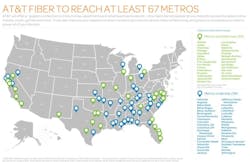AT&T says it plans to deliver its "ultra-fast internet" service to 11 new metro markets, which would increase its planned network footprint to 67 metro areas. The company says the service, which it has rechristened "AT&T Fiber" from the less phonetically efficient "AT&T U-verse with GigaPower," should be available in 45 markets by the end of this year. However, despite the use of the word "fiber" in its new brand name, the service provider adds it plans to deliver the gigabit services using multiple technologies.
The company currently delivers gigabit services in parts of 29 markets, principally if not entirely via fiber to the premises (FTTP; see map above). AT&T says it markets the service to more than 3 million locations, including more than 500,000 apartment and condo units. The company says it expects to be able to offer gigabit services to more than 12.5 million locations by mid-2019.
The 11 new markets include:
- Florida: Gainesville and Panama City
- Georgia: Columbus
- Kentucky: Central Kentucky
- Louisiana: Lafayette
- Mississippi: Biloxi-Gulfport and Northeast Mississippi
- North Carolina: Wilmington
- Tennessee: Southeastern Tennessee and Knoxville
- Texas: Corpus Christi.
The service provider did not detail which technologies besides fiber-optic broadband it plans to use in its gigabit markets, other than to say, "We will announce additional network technologies and products in our AT&T Fiber umbrella brand in the near future." However, the company is taking a hard look at G.fast, particularly to deliver broadband services to subscribers in multiple dwelling units (MDUs) via existing in-building coaxial cable. Whether AT&T would consider G.fast as a direct upgrade for current DSL lines is unknown.
AT&T first launched its GigaPower offering in Austin, TX, in 2013, starting with a 300-Mbps service (see "AT&T to launch 1-Gbps FTTH in Austin" and "AT&T launches 300 Mbps U-verse in Austin with 1 Gbps on the way").
For related articles, visit the FTTx Topic Center.
For more information on FTTx equipment and suppliers, visit the Lightwave Buyer's Guide.

Stephen Hardy | Editorial Director and Associate Publisher
Stephen Hardy has covered fiber optics for more than 15 years, and communications and technology for more than 30 years. He is responsible for establishing and executing Lightwave's editorial strategy across its digital magazine, website, newsletters, research and other information products. He has won multiple awards for his writing.
Contact Stephen to discuss:
- Contributing editorial material to the Web site or digital magazine
- The direction of a digital magazine issue, staff-written article, or event
- Lightwave editorial attendance at industry events
- Arranging a visit to Lightwave's offices
- Coverage of announcements
- General questions of an editorial nature
